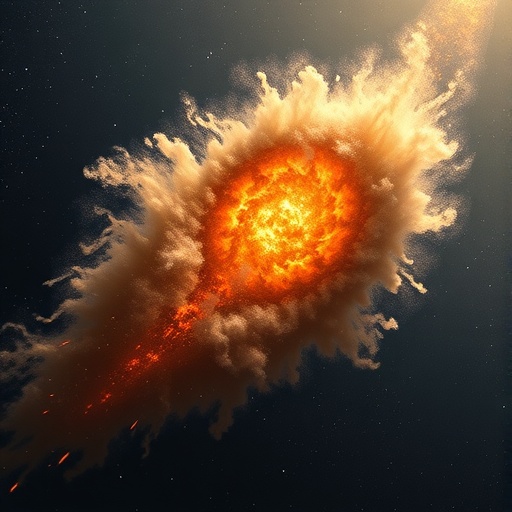Since the dawn of our planet’s existence, the Earth has been bombarded by innumerable particles from space, each one a remnant of the cosmos. These micrometeorites, often small and ephemeral, leave traces that are visible to the naked eye on clear nights as fleeting shooting stars. What is less visible, however, is the treasure trove of scientific information hidden within these ancient particles, which capture a slice of our planet’s historical atmosphere. An international team of researchers, spearheaded by scholars from the University of Göttingen, has innovatively tapped into these cosmic relics to unlock previous atmospheric conditions through a groundbreaking methodology applied to fossilized micrometeorites. Their illuminating findings have been documented in the prestigious journal Communications Earth & Environment, marking a significant leap in our understanding of Earth’s climatic past.
As meteorites plummet through the Earth’s atmosphere, they undergo a process of melting and chemical transformation. Metallic components, such as iron and nickel, are particularly susceptible to oxidation upon contact with atmospheric oxygen. This transformation triggers a fascinating metamorphosis, leading to the formation of tiny, spherical structures composed of oxide minerals. The oxygen within these structures originates from the air itself, thus imprinting atmospheric characteristics onto these minute particles. Each year, countless such micrometeorites make their journey to Earth, laying down a wealth of information capable of serving as a chemical chronicle of the atmosphere at various points in geological history.
The research team successfully developed an innovative method that allowed them to analyze micrometeorites from distinct geological epochs, with an unprecedented level of precision regarding the isotopic composition of oxygen and iron. These isotopic ratios present a window into the environmental conditions during the periods when these micrometeorites formed. More intriguingly, this research provides vital data regarding historical carbon dioxide concentrations, shedding light on the intricate interplay between atmospheric conditions and organic life, particularly the role of photosynthetic plants in shaping the atmospheric landscape.
What the researchers discovered suggests that these minuscule spheres are not just random remnants but rather valuable additions to the toolkit utilized in geological climate studies aimed at reconstructing past atmospheric conditions. Dr. Fabian Zahnow, the lead author of the study and a former doctoral researcher at Göttingen University, noted the notable preservation power of these micrometeorites. Despite their diminutive size, they successfully retain reliable isotopic signs throughout millions of years, functioning as time capsules of atmospheric history. However, the research also unveiled the complexities of geochemical processes that micrometeorites undergo once they land on terrestrial surfaces, emphasizing that meticulous geochemical assessment is paramount to ensure accurate interpretations of data.
The implications of this research extend far beyond mere atmospheric reconstruction. Understanding the historical context of CO2 concentrations and the biological implications of ancient atmospheric compositions can significantly enhance our knowledge of climate change, offering invaluable insights into how life has evolved in response to changing environmental factors. The documentation of the study elucidates a vital interaction between Earth’s past climate and the ancient life forms that inhabited the planet, thus enriching our comprehension of how photosynthetic processes influence elemental distributions over geological timeframes.
Moreover, micrometeorites represent a unique type of sample that might elucidate the ancient attributes of our planet’s atmosphere in ways that other methods cannot achieve. Utilizing these tiny geological archives, scientists can fill in critical gaps in our knowledge of atmospheric evolution, particularly during periods that lack comprehensive terrestrial records. This advancement is notably crucial as we grapple with contemporary climate challenges and seek to understand Earth’s climatic oscillations over extensive geological timelines.
The research stands as a testament to the multidisciplinary collaboration between institutions spanning multiple countries, illustrating how collective expertise from various scientific fields can lead to innovative methodologies and breakthroughs. Efforts such as this underscore the importance of think tanks comprising geoscientists, chemists, and researchers dedicated to unveiling the complexities of the natural world. As these scientists sift through layers of history imprinted in these space-fallen particles, they renew our appreciation for the intertwined nature of Earth’s atmospheric evolution and scientific inquiry.
As scientists continue to fine-tune the methods used for analyzing micrometeorites, we can anticipate even more discoveries arising from these cosmic relics. Future research promises to refine our understanding of the atmospheric conditions that predated human existence on this planet while potentially unlocking vital insights into the potential responses of life to changing climates. This novel research avenue challenges us to look closer at the very particles that collide with our planet and encourages a deeper exploration of their roles as records of life in its myriad forms.
The findings from the Göttingen-led research emphasize Earth’s dynamic processes over millions of years, demonstrating how interstellar materials continue to impact terrestrial environments. As researchers move forward with this line of investigation, they reinforce the notion that even the smallest materials can have profound significance in understanding the grand narrative of our planet’s history and its continued evolution.
In conclusion, the innovative work established by the Göttingen research team not only opens a new realm of inquiry into Earth’s atmospheric history but challenges the scientific community to rethink how we study climate transitions and the mechanisms that inform our understanding of environmental change. The revelations contained within micrometeorites herald a new frontier in atmospheric research, beckoning scientists to delve deeper into these tiny, yet immensely significant, carriers of ancient secrets from space.
Subject of Research: Fossilized micrometeorites and their isotopic analysis of Earth’s ancient atmosphere
Article Title: Traces of the oxygen isotope composition of ancient air in fossilized cosmic dust
News Publication Date: 23-Jul-2025
Web References: https://doi.org/10.1038/s43247-025-02541-5
References: Communications Earth & Environment
Image Credits: Fabian Zahnow
Keywords
Micrometeorites, Earth’s atmosphere, atmospheric history, isotopic analysis, climate change, geology, oxygen isotopes, environmental science, ancient air composition, cosmic dust.




